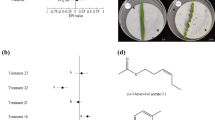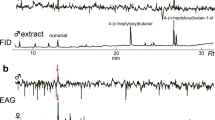Abstract
Anoplophora glabripennis (Motsch.) is a woodboring beetle that is native to China. For a long time, it caused great losses in the economy and ecology of northwest China. Attractants are often used to control insects. The volatiles emitted from the host plant play an important role for insects in finding their target. To explore the mechanism of selectivity to different host plants, the response of Anoplophora glabripennis to four different host plants was investigated, which included Acer negundo L., Acer mono Maxim., Acer truncatum Bunge. and Acer platanoides L., and the compounds in the profiles of volatiles were identified from these species. The olfactory responses of Anoplophora glabripennis to the odors of different plants showed preference for certain host plants: Acer negundo, Acer mono and Acer truncatum. The attraction of Acer negundo and Acer mono was significantly different (p<0.05). The attraction of Acer negundo to the insects was stronger than to Acer mono. Acer platanoides neither attracted nor repelled the insects. Compounds in the profiles of volatiles from the above four species were identified and quantified by gas chromatography-mass spectrometry (GC-MS) equipped with a CP-4020 termodesorption and cold trap (TCT) device. The constituents of volatiles and the relative concentrations were different in the four host species. The amount of ketones, alcohols and aldehydes in the four plants showed the same order: Acer negundo<Acer mono<Acer truncatum<Acer platanoides, while that of alkanes and esters was quiet different: Acer negundo L.>Acer mono Maxim.>Acer truncatum Bunge.>Acer platanoides L.. 1-penten-3-ol, ocimene and trans-Germanylacetone were repellent to Anoplophora glabripennis. 1-penten-3-ol and trans-gerranylacetone were identified in Acer platanoides, and Ocimene was the most attractive to Anoplophora glabripennis among these species. The extent of feeding damage caused by Anoplophora glabripennis differed among four species. The sequences was Acer negundo>Acer mono>Acer truncatum>Acer platanoides. The epidermal hairs of the four host plants revealed that the extent of damage was related to the physical characteristics of the host plants.
Similar content being viewed by others
References
Auger M, Bastien C, Geri C (1991). Edibility of different clones of Scots pine for Diprion pini L., (Hym., Diprionidae). III. Prospects for the genetic improvement of Scots pine. Journal of Applied Entomology, 111(3): 270–277
Eom T, Son D, Lee S (1998). Resistance to pine gall-midge and phenolic acid content in pine needles. Journal of the Korean Wood Science and Technology, 26(3): 33–40
Frédéric F, Georges L, Eric H (2004). Olfatory responses to aphid and host plant volatile releases: (E)-Farnesene an effective kairomone for the predator Adalia bipmctata. J Chem Ecol, 30(4): 741–755
Haack R A (2003). Research on Anoplophora glabripennis in the United States. Nachrichtenbl Deut Pflanzenschutzd, 55: 68–70
Hanks L M (1999). Water relations of host trees and resistance to the phloem-boring beetle phoracantha semipuncatata F. (Coleoptera: Cerambycidae). Oecologia, 119: 400–407
Hanks L M, Paine T D, Millar J G (1991). Mechanisms of resistance in Eucalyptus against larvae of the eucalyptus longhorned borer (Coleoptera: Cerambycidae). Environmental Entomology, 20: 1,583–1,588
Hanks L M, Paine T D, Millar J G, Hom J L (1995). Variation among Eucalyptus species in resistance to eucalyptus longhorned borer in Southern California. Entomologia Experimentalis et Applicata, 74: 185–194
Hensley D L, Wiest S C, Long C E, Pair J C, Gibbons F D III (1991). Evaluation of ten landscape trees for the Midwest. Journal of Environmental Hoticulture, 9: 149–155
Hirotaka T, Shuichiro M (1996). On the polyphenolic of them to the resistance to chestnut gall wasp. Japan Soc Hort Sci, 35: 89–97
Hulme M A (1995). Resistance by translocated Sitkaspruce to damage by Pissodes strobi (Coleoptera: Curculionidae) related to tree phenology. J Econ Entomol, 88: 1525–1530
Keena M A (2002). Anoplophora glabripennis (Coleoptera: Cerambycidae) fecundity and longevity under laboratory conditions: Comparison of populations from New York and Illinois on Acer saccharum. Environ Entomol, 31: 490–498
Kessler A, Baldwin I T (2001). Defensive function of herbivore-induced plant volatile emissions in nature. Science, 291: 2141–2144
Kuser J E, Robinson G, Polanin N (2001). Four-year evaluation of five cultivars of Pyrus calleryana. Journal of Arboriculture, 27: 88–91
Li Dingxu, Hou Yueli, Shen Zuorui (2005). Influence of host plant species on the development and reproduction of hawthorn spider mite Tetranychus viennensis Zacher. Acta ecologica sinica, 25(7): 1562–1568
Li Huiping, Wang Zhigang, Yang Minsheng, Zhang Y G, Zhang S H, Huang D Z (2003). The relation between tannin and phenol constituents and resistance to Anoplophora glabripennis of various popular tree species. Journal of Agricultural University of Hebei, 26(1): 36–39
Li Jianguang, Jin Youju, Luo Youqing, Shen Yingbai, Chen Huajun (2002a). Comparative analysis of volatile compounds from different host plants of Anoplophora glabripennis (Motsch.). Journal of Beijing Forestry University, 24(1): 165–169
Li Jiquan, Fan Hui, Jin Youju, Chen Huajun (2002b). Emission mechanism of volatile compounds from ashleaf maple feeding-damaged by Anoplophora glabripennis (Motsch.). Journal of Beijing Forestry University, 24(5–6): 170–174
Li Jiquan, Fan Hui, Jin Youju (2003). Behavior response of Anoplophora glabripennis to the mechanical-wounded and herbivore-fed ashleaf maples. Journal Beijing Forestry University, 25(5): 42–46
Luo Y, Wen J, Xu Z (2003). Current situation of research and control on popular longhorned beetle, especially for Anoplophora glabripennis in China. Nachrichtenbl Deut Pflanzenschutzd, 55: 66–67
Morewood W D, Hoover K, Neiner P R, McNeil J R, Sellmer J C (2004). Host tree resistance against the polyphagous wood-boring beetle Anoplophora glabripennis. Entomologia Experimentalis et Applicata, 110: 79–86
Nerg A M, Heijari J, Noldt U, Viitanen H, Vuorinen M, Kainulainen P, Holopainen J K (2004). Significance of wood terpenoids in the resistance of Scots pine provenances against the old house borer, Hylotrupes bajulus, and brown-rot fungus, Coniophora puteana. Journal of Chemical Ecology, 30(1): 125–141
Nowak D J, Pasek J E, Sequeira R A, Crane D E, Mastro V C (2001). Potential effect of Anoplophora glabripennis (Coleoptera: Cerambycidae) on urban trees in the United States. J Econ Entomol, 94: 116–122
Schneider D (1986). Plant recognition by insects: A challenge for neuroethological research. In: Labeytie V, Fabres G, Lachaise D, eds. Insect-Plant Relationships, 117–124
Smith M T, Bancroft J (2002). Age-specific fecundity of Anoplophora glabripennis (Coleoptera: Cerambycidae) on three tree species infected in the United States. J Econ Entomol, 94: 116–122
Takabayshi J, Dicke M, Posthumus M A (1991). Variation in composition of predator-attacting allelochemicals emitted by herbivore-infested plants, relative influence of plant and herbivore. Chemoecology, 2: 1–6
Van den Boom C E M, van Beek T A, Dicke M (2003). Differences among plant species in acceptance by the spider mite Tetranychus urticae Koch. Journal of Applied Entomology, 127: 177–183
Visser J H (1986). Host odour perception in phytophagous insects. Ann Rev Entomol, 31: 121–144
Visser J H, Yan F S (1995). Electroantennogram responses of the grain aphids Sitobion avenae (F.) and Metopolophium dirhodum (Alk.) (Homoptera: Aphidiae) to plant odour components. J Appl Ent, 119: 539–542
Wei Hairong, Li Fenglan (1995). Some relationship between leaf structure and resistance to insects of elms. Journel Beijing Forestry University, 4(1): 17–26
Wen Junbao, Ye Gang, Li Zhenyu, (1998). Relationship between bark thickness of poplars and damage caused by Anoplophora glabripennis (Motschulsky). Hebei Journal of Forestry and Orchard Research, 13(2): 136–140
Yang Xueyan, Zhou Jiaxi, Yan Xinhu (1992). The relation between the harmfulness of longicorn and morphological characteristics and dissection structures of tress. Journal of Northwest Forestry University, 7(3): 34–43
Zhu J, Cosse A A, Obrycki J J, Boo K S, Baker T C (1999). Olfactory reactions of the twelve-spotted lady beetle, Coleomegilla maculata and the green lacewing, Chrysoperla carnea to semiochemicals released from their prey and host plants: Electroantennogram and behavioralresponses. J Chem Ecol, 25: 1163–1177
Author information
Authors and Affiliations
Corresponding author
Additional information
__________
Translated from Acta Ecologica Sinica, 2006, 26(3): 870–877 [译自:生态学报]
Rights and permissions
About this article
Cite this article
Zhang, F., Jin, Y., Chen, H. et al. Selectivity mechanism of Anoplophora glabripennis on four different species of maples. Front. Biol. China 3, 78–84 (2008). https://doi.org/10.1007/s11515-008-0006-1
Issue Date:
DOI: https://doi.org/10.1007/s11515-008-0006-1




